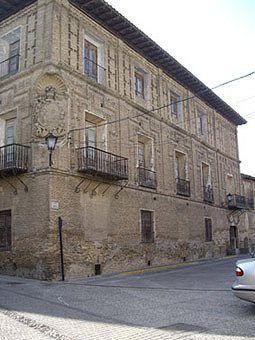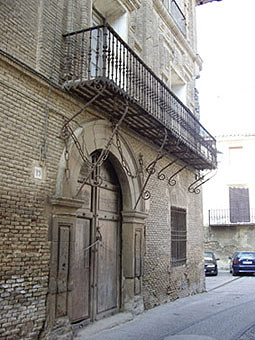The piece of the month of August 2006
HOUSE OF THE SESMA FAMILY. CORELLA
Pilar Andueza Unanua
Chair of Navarrese Heritage and Art
During the centuries of the Baroque period, Corella experienced moments of great splendour and development, which were reflected in the demographic and urban growth of the town as well as in its monumentalisation and embellishment thanks to the construction of several convents, the extension, remodelling and ornamentation of its two parishes and, above all, the proliferation of a series of ancestral homes and stately residences. The reason for this is to be found in the economic developmentthat Corella experienced during the second half of the 17th and 18th centuries. The particular customs legislation of Navarre and the strategic geographical location of Corella, next to the Castilian border, allowed many of its inhabitants to participate in a thriving trade based on redistribution: they bought Castilian wool that they sent to France for textile processing and from there they imported luxury manufactured goods and spices that they introduced into the market Spanish, a commercial traffic that they always carried out through Navarre. groupThis economic policy generated important fortunes in a large number of local families, who, imitating the old nobility, took steps to achieve a parallel social recognition. The construction of a main house for the family, heading an entailed estate with most of its assets, was the culminating point in this process. The building would be a symbol of the power achieved in the eyes of the neighbours, and would also be capable of lasting over time.
Among the most outstanding houses built at this time is the one known as the Casa de las Cadenas (House of the Chains). This is the residency programof the Sesma family, a saga dedicated to business, many of whose members also held important posts in the army and in the high administration of the Bourbon state: colonels, brigadiers, admirals, captains, naval commissioners, a corregidor of Mexico City, a guardajoyas of Queen Mariana of Neoburg, as well as professors, lawyers and judges. Several of them also wore the habits of the orders of chivalry of Calatrava, Santiago and Carlos III.

House of the Sesma family. Corella
The building has its origins in the figure of Agustín de Sesma y Sierra. Born in 1664 in Corella, his business was centred on the wool trade, although he diversified his income, for example, by leasing the rents of the royal boards and entering the field of military seats. The scope of his business extended as far as Madrid and Cadiz, as well as to France and Holland. In 1691 he married Josefa Escudero y Ruiz de Murillo, also from Corella, daughter of another local merchant. They had sixteen children, of whom two daughters, Isabel and Agustina, and six sons survived: Agustín, Zenón Bernardo, José Pedro, Felipe, Luis and Miguel, who received each entailed by their respective marriages, marriages that were perfectly studied and calculated in order to maintain the social pre-eminence and the family business.
The building was constructed on top of some houses that Josefa received as a dowry from her father in 1691, which were completed with other adjoining houses that the couple bought in 1697 from Martín Escudero, her brother. Once those buildings had been demolished, this superb construction began in 1704. A year later, on 17th October, Agustín and Josefa founded an entailed estate to which they linked a large part of their property and at the head of which they placed this house, which they declared "was built by us". Their first-born son Agustín, who followed in his father's commercial footsteps, was to succeed them in that bond, as he did.
The house became the royal residency programfor a few months. On 14 June 1711, Philip V arrived in the city, accompanied by his wife, Mª Luisa Grabiela of Savoy, together with their young son, Louis, Prince of Asturias. They were looking for a cure for a sick queen. They stayed in this house until their departure in October. In 1712, the monarch granted Agustín the royal mercy of placing chains on the doors of his house, a privilege granted to the houses that had given accommodationto the king. Since then, the building has been popularly known as Casa de las cadenas (House of Chains). In 1753, the then owner of the building, Agustín de Sesma e Imbulsqueta, grandson of the developer of the building, was also granted a seat on the arm of the Knights of the Cortes of the Kingdom of Navarre.
The building is a markedly horizontal block with three sections, above which the main staircase rises. As is typical of the Ribera style, it is built in brick and has two façades, one opening onto Placeta García and the other onto Calle de San Miguel. It is here, off-centre, where the main doorway is located. With a semicircular arch between Tuscan pilasters, its structure is very similar to other examples from Corella. The main floor is articulated by means of pilasters between which there are large balconies with projecting frames, wide overhangs and superb chiselled iron grilles. The building is crowned by an attic with windows and balconies.

House of the Sesma family. Corella. Detail
A magnificent heraldic engraving made in 1706 is located on the corner of the building. This is a very unusual location in Navarre. However, from Calle de la Reja street, this coat of arms acquires all its splendour thanks to a magnificent perspective, a baroque perspective, which of course enhances and serves as an attraction for passers-by. It bears the coat of arms of the Sesma, Escudero, Sierra and Ruiz de Murillo families, from agreementwith the noble title obtained from the royal courts in 1704.
From agreementwith the typical characteristics of the stately architecture of the Ribera de Navarra, and even of the Ebro axis, it is a building of great plasticity, thanks to the geometric games in the arrangement of the brickwork, which give it interesting lighting effects and movement, elements typical of Baroque aesthetics.
